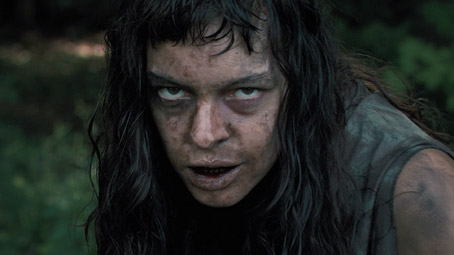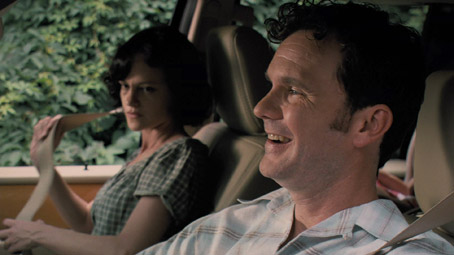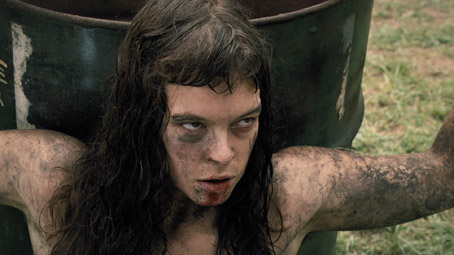| |
"I'm not borrowing technique from the last five years, I'm borrowing technique from the last 140 years, so someone's like "Oh, it makes me feel like I felt when I saw a Hitchcock picture in 1960."* |
| |
Lucky McKee, interviewed by the Onion A.V. Club |
The common adage thrown around these days concerning digital video technology is that it has "set the filmmaker free" – now that even the average consumer-grade camcorder can shoot 1080p at 24fps, anyone can make a film. Even established filmmakers have jumped on the bandwagon, most notably David Lynch, who has sworn off ever working on film again following the completion of Inland Empire. The medium of celluloid is dying, swiftly replaced by the ease and cost-effectiveness of digital—but towering auteurs like Lynch and Lars von Trier aside, digital hasn't so much "set the filmmaker free" as it has opened the floodgates to their most self-indulgent pretensions.
Lucky McKee's The Woman arrives with incredible buzz, riding a wave of controversy and acclaim, many hailing it as a return to form for the infamously bedogged McKee, whose career following his debut has mostly been a trail of producer-mangled failures and an episode of Showtime's Masters of Horror series. His fantastic first film, May, is still rightly regarded as one of the best horror films of 'aughts', and fans have been waiting for McKee to deliver on a level of quality befitting it ever since. From afar, The Woman would seem to be just that: Angela Bettis once again returning in a lead role, a tempestuous reaction at Sundance, and an intriguing setup that seems rife for tackling more than bloodletting and shock gags. Working from the novel they co-wrote, McKee and author of grisly cult horror Jack Ketchum concoct a scenario that seems more in line with something the aforementioned von Trier would film than what the patrons of "Fright Fest" clamour for: Sean Bridgers' upstanding redneck patriarch takes a break from cookouts—and occasionally slapping his wife around—for a hunting trip in the woods, whereupon he comes across the titular forest-dwelling savage. Smugly endeavouring to "civilize" her, he smacks her over the head with a rifle butt and chains her up in his cellar. In the spirit of forerunners like Dogville, Bridgers' warped altruism turns into nasty sadism, as he teaches the woman that being civilized means shutting up and submitting to rape and abuse for the benefit of the men around her, most disturbingly including his preteen son.

Most of McKee's usual fixations are here—the rampant disconnect between people along the lines of gender and relationships, and how those divides eventually manifest through violence. Perhaps the most interesting thread running throughout McKee's work, and again recurring here, is his treatment of lesbianism. Whereas most male horror filmmakers use lesbian characters for predictably baser reasons, McKee's are treated as human beings whose sexual orientation is simply a part of their personality, and not an excuse to stage a superfluous makeout scene (although Carlee Baker, here playing a schoolteacher who gets a bit too curious, is introduced in an eye-rollingly leering fashion, with the camera trailing her high-heels as she seductively saunters down a row of desks). The Woman's script is for the most part excellent, even if its satire is occasionally blunt and its dialogue sometimes cringingly arch (the first line of the film features a dejected young suitor calling someone a "strumpet" without the slightest trace of irony). The twists the story takes are chillingly inventive, and even if the film's observations of middle-American family values aren't the most original, they are at least powerfully put across by a screenplay that doesn't chicken out in the last act.
It is painful then to see The Woman thwart itself at every turn with truly woeful choices in execution. The assured hand behind May seems to have been replaced here by a novice filmmaker who has just discovered the magical world of digital video; the film's cinematography is drab and lifeless and unpleasant in a way that is simply deadening instead of repellently fascinating (see Inland Empire, where the horror imagery and digital look work together flawlessly). McKee states on the extras that he wanted to shoot a horror film in which the most horrific incidents took place in broad daylight, but the connective association of this idea only really comes across in the final scenes, where we see the full of extent of "father knows best" grotesquely taken to the extreme.
McKee's further undoing is his indulging of every cheap looking edit that could be teased out of whatever software suite was at editor Zach Passero's disposal. With film, many of the more questionable editing decisions can mercifully fall by the wayside due to the essential limitations of the format. Digital, on the other hand, allows filmmakers to do whatever they like in an instant with just the press of a button. With The Woman, McKee torpedoes narrative momentum and respectability every five minutes, cutting to the next scene not because it's the logical point of conclusion but because the scenes themselves seem to be running out of steam. Too often he unimaginatively (and pointlessly) resorts to Zack Synder-style 'speed-up/slow-down' post-production image manipulation, music video superimpositions or unnecessary flash cuts. For all the moments in which the film feels more like a trailer to a nineties teen slasher film, it might as well be, given the shameless shoehorning of yet another poorly-cut montage set to the film's godawful alt-rock soundtrack. Some have defended this choice in the name of "satire", but that defence only holds water during the woman's introduction and the tormented teenage angst of daughter Peggy (Lauren Ashley Carter) living her own private hell at high school—every other instance where Sean Spillane's musical contribution rears its ugly head seems less like satire and more like the fulfilling of a particularly aggressive product placement contract.

The cut-rate execution is downright shocking—every scene in The Woman plays like a first take, the performances never quite hitting the peak they need to (Pollyanna McIntosh excepted, playing the Woman with so much guttural ferity you begin to believe that she must have gone through some debasing actor's technique to unlearn all her identifiably human traits). Angela Bettis, so good as the shellshocked housewife for most of the running time, is given short thrift in her major dramatic scene late in the film, as if, in Ed Wood fashion, Bettis delivered her lines once and McKee yelled "Moving on!" With a bigger budget and more time, The Woman could have justified all the horror fanboy praise heaped upon it, but directorially, photographically, editorially and musically, The Woman leaves a lot to be desired, and falls far short of the bewildering critical acclaim and hype. It's inarguably one of the year's most memorable entries, though not necessarily just for the reasons quoted on the film's poster.
A note from Slarek: It's a rare thing that we share the duties of reporting on the sound and picture quality of a disc, but it became necessary here for the simple reason that we just couldn't agree on the technical merits and demerits of what the disc had to offer. As site editor I've thus decided to post both sets of comments, not so that one should contradict the other, but to illustrate how widely the quality of an image can vary from set-up to set-up. I seem to have fared rather better here than Tim, but the fact that the disc plays rather well on my system (one I spent some considerable time selecting and fine tuning, I should point out) does not mean it will do so on on all players and screens, as Tim's coverage illustrates. And so to the reports...
Tim:
Revolver Entertainment stumbles with its presentation of The Woman on Blu-ray, though to be fair, this may owe more to the source than anything. The transfer is certainly watchable enough, but it's soft and indistinct, and there are occasional problems with noise.
The audio likewise is a disappointment, again owing less to the presentation and more to the source; the film's DTS Master Audio track is hastily assembled and poorly mixed, a crude assemblage of muffled production audio that resulted in my having to rewind key lines of revelatory dialogue and still not getting the jist of what was being said. The overly-loud music is no help either, and this was a rare occasion where subtitles were sorely missed.

Slarek:
On my system the picture detail is actually rather good, and at its best (usually daylight exteriors) is often impressive, particularly skin or clothing textures, foliage and old favourites like wood grain and head hair. The contrast is solid enough, though with the usual small perils of shooting on high-def digital such as burnt out whites and detail-swallowing shadows, particularly in the gloom of the cellar in which the Woman is held prisoner, and there are a lot of scenes down there. Digital grain is also more evident on these sequences. It has to be said that the toned-down colour scheme does make the image look rather drab at times.
There's a choice of soundtracks between LPCM stereo and what the menu claims is Dolby 5.1 surround but is actually DTS-HD Master Audio surround. The DTS track is certainly more inclusive than the stereo track and makes specific use of the surrounds for ambient sound and certain sound effects (dogs barking, an off-camera scream).
The Making of The Woman (24:48)
I'd listed so many questionable directorial choices by the time the credits rolled that I genuinely couldn't wait to hear the ever-articulate McKee state his case and make his justifications. Alas, no commentary track, which I'm sure would have warranted a second viewing of the film. The 'making of' attempts to fill that gap, with talking heads giving their take on the story and the characters without really ever illuminating what the film has to say on any level below the surface. Of far greater interest is the dynamic between McKee and Ketchum, each not prepared to listen to the other's bullshit when it came to hitting false notes in the screenplay. Their collaboration certainly yielded a story that sets the bar for darkly absurd turns and which forges ahead on its own path, never feeling or sounding like an easy to categorize genre film. We also get a close-up look at the astounding work of the make-up department and witness an impressive time-lapse transformation of Pollyanna McIntosh from upbeat, fun-loving actress to savage primitive. The delight with which the special effects technicians ply their trade in gore reminds very much of the "blood is more" enthusiasm of Greg Nicotero whilst working on Sam Rami's Evil Dead II. We're also granted a rare look at the work of sound designers on an indie film as Andrew Smetek explains his approach to perhaps the film's single most effective moment, where sound plays a major part in cuffing the viewer in the Woman's shackles. As if dousing the whole documentary in Sean Spillane's musical contributions wasn't enough, we get an extended chat with the composer where he reveals his songs to be more influenced by the location in which they were recorded rather than the subject of the film itself, which goes a long way in explaining their erroneous disconnect. He also reveals that he and the director were friends since college, surely an example where a long enduring friendship got in the way of what was best for the film. The documentary concludes with a visit to the film's premiere at Sundance.

Deleted Scenes (05:14)
Four omissions which highlight the overuse of cross-fades in the edit suite, and more kitchen table neglect at the hands of the husband. The major point of interest here is
the development of the high school teacher's lesbian relationship, only fleetingly glimpsed in the final cut, which also delves deeper into her otherwise ambiguous concern for Peggy.
Meet The Makers (04:24)
Comprised of re-cut footage culled from the main documentary, this is far from your typical love fest. There's mutual respect as well as reverence between all the principles interviewed. Detailing how the producer and director met, this promo for a TV network also shows how a local high school basketball court was used to create a soundstage (not a hugely successful venture given the recording of the dialogue in the finished film), though I'm hardly buying editor Zach Passero's assertion that "there's not a single wasted image in the film", the one instance of frothy-mouthed backslapping.
Short Film - Mi Burro (07:02)
Screamingly twee animated flight of fancy, strictly for hipsters only. The only connection it has to the feature is that the film itself has a post credits animated coda equally as grating and nonsensical. Like many scenes in the film, the short can't be bothered to properly conclude.
The Film4 FrightFest Total Film panel with Lucky McKee, Andrew van den Houten, Adam Green, Joel Lynch, Ti West and Larry Fessenden (42:56)
Easily the disc's best extra, this dream collective of fringe horror icons talk to a rapt crowd at what has now become arguably the world's biggest and most popular festival devoted to horror films. The directors bemoan the fact that horror is in a bad place, despite all of them having struck out from the Platinum Dunes dreck clogging up your local multiplex. House of the Devil director Ti West immediately addresses the elephant in the room, asserting that the only way the dominance of bad horror will fail is by the will of the fans refusing to pay to see crappy remakes on the big screen. Lucky McKee talks about what makes his contemporaries gathered on the stage different from most horror directors, largely drafted from commercials and used to doing what the client wants, "shooting the Doritos in ten different ways." They collectively reminisce on bad studio experiences, as it seems all of them have been handed a remake or two that they where eventually fired from, and this open refusal of diplomacy, while not exactly bridge-burning, is refreshingly candid. The group have so much to say that when it comes time to open it to the crowd they're only able to squeeze in two questions, though this may also be down to Hatchet director Adam Green hijacking much of the conversation. Every inch a frat boy, he has just as much charm, and after forcing myself to sit through his commentary for Frozen, I could've done with far less from him.
Music Track - "Distracted' by Sean Spillane (05:01)
The Woman is arguably already a feature length music video, and Spillane's music is splashed all over this disc already. Thanks, but no thanks.
Hell hath no fury like a scorned film fan duped by the hype machine. The Woman squanders an excellent premise one of the year's best scripts with its amateur hour stylings. Chief amongst the film's many offences is its middling digital photography—lacking either the handheld grit of low-end consumer video or the sleek, velvety beauty conjured by a moneyed auteur, Lucky McKee's latest is an ugly mess in more ways than one, and an unequivocal disappointment.
* Of that 140 years, most of the technique borrowed is from 90's MTV-edited teen slashers, 00's music videos and the whole toolbox of gimmicky Zack Synder trailer shots. Hitchcock this guy ain't.
|